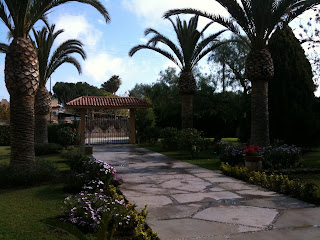The historic center in Siracusa is situated on a small island called Ortigia, which separates the city’s two harbours. The old-town was built by the Greeks, who started with the construction of a huge temple to honour Apollo in the 6th-century BC. The temple is the oldest example of the Doric style in Europe, and is an impressive sight as you first enter the island.

The rest of Ortigia is almost as impressive, with its twisty cobbled streets and huge piazzas. The city’s Cathedral dominates Piazza Domo with an imposing Baroque façade and the original columns from a 6th-century monument to Athena still visible as part of the north wall.


The next destination on our list was the Archaeological Zone, which lies just north of the main city-center. A twenty minute walk in the afternoon sunshine and we were there. The main attraction of the Archaeological Zone is the Greek Theatre, built in the 5th-century BC. Perhaps unbelievably, the theatre is still used for performances of classical Greek pieces, but unfortunately for us they only put on shows in even-numbered years.


A stone’s throw from the Greek Theatre is a Roman Amphitheatre, which whilst smaller and less well maintained than its Greek neighbour, is still impressive in its own right.


The Archaeological Zone also includes a huge quarry where most of the stone used to build Siracusa was excavated from. Around the edges of the quarry lie large grottos carved out of the stone, the most famous of which is ‘The Ear of Dionysius’. Luckily it wasn't the 'Eye of Dionysius' since we had to change "mini" on a bench just outside this cave.


We could have wandered around the site for at least another hour, but evening was fast approaching and we had to find our way to our next B&B, which we thought was on the outskirts of Siracusa. We weren’t looking forward to tackling the horrific one-way system again, but our experience on the way in had given us some idea of the layout and we were able to escape the center without too much hassle. Twenty minutes later and we arrived at the appropriately named Dolce Casa and “mini” was glad to finally escape the car. We were welcomed by the friendly owner with cool home made blood orange juice waiting for us in the room with its own patio towards the lush garden.



After playing around in the room with “mini” for a little we inquired about a good local restaurant and were directed to the Pharao, where we all enjoyed a lovely meal in a beautiful setting, overlooking the sea. After a good night’s sleep and another delicious breakfast, unfortunately our trip was coming to an end. We headed back out on the road for the long journey home.



Even if it takes more planning and less spontaneity to travel with a baby, we were sure that we would do this again if we ever come back to Sicily. But for right now, we were just looking forward to getting back to our Sicilian home and to enjoy the sea and the sun for a while.
No comments:
Post a Comment